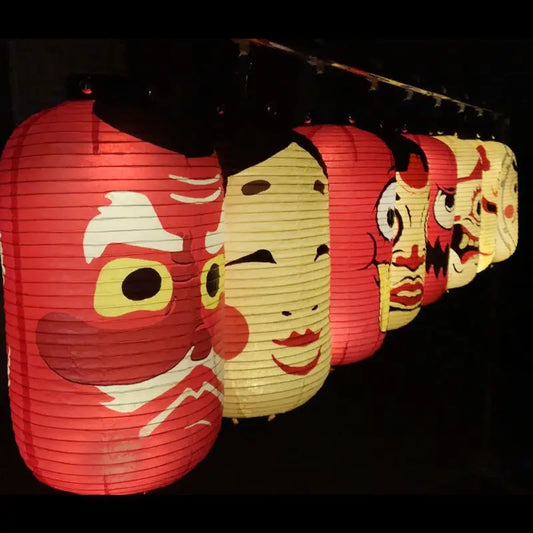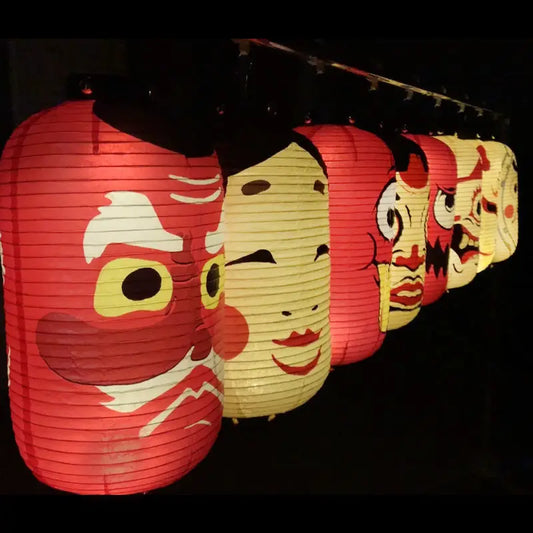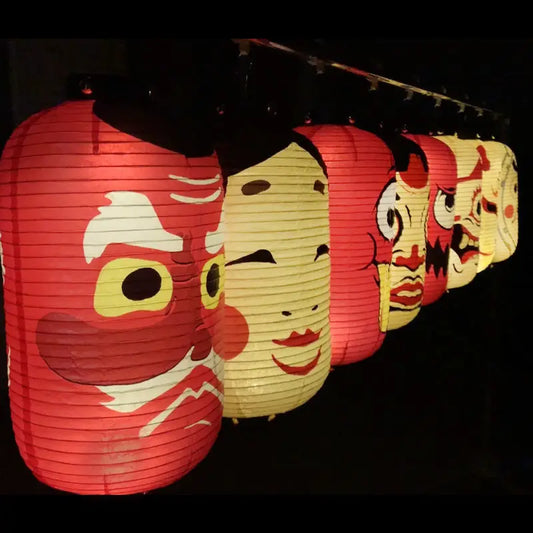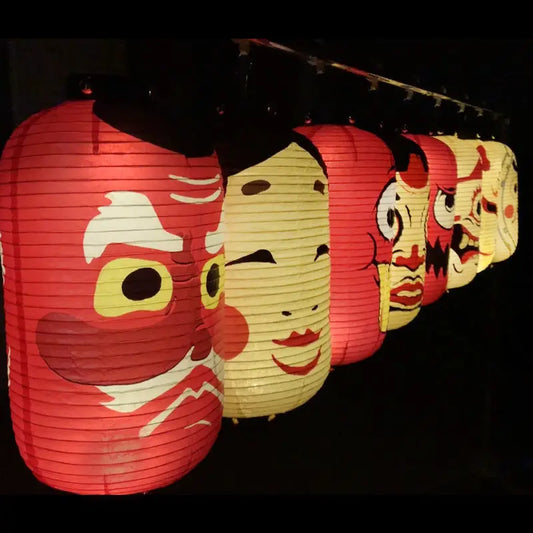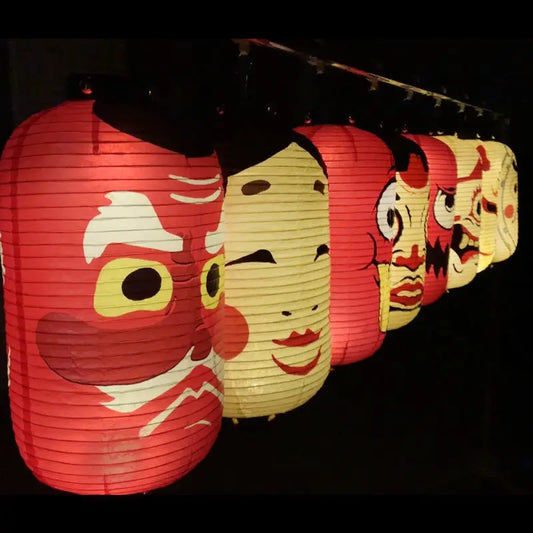Collection: Japanese Lanterns
-
Red Tengu Lantern
Regular price From 35$ USDRegular priceUnit price / per -
Noh Face Lantern
Regular price From 35$ USDRegular priceUnit price / per -
Spooky Cyclop Lantern
Regular price From 35$ USDRegular priceUnit price / per -
Kitsune Fox Lantern
Regular price From 35$ USDRegular priceUnit price / per -
Freaky Cyclop Lantern
Regular price From 35$ USDRegular priceUnit price / per -
Cheeky Cyclop Lantern
Regular price From 35$ USDRegular priceUnit price / per -
Noh Theatre Mask Lantern
Regular price From 35$ USDRegular priceUnit price / per -
Egg Face Lantern
Regular price From 35$ USDRegular priceUnit price / per -
Koi Fish Spirit Lantern
Regular price From 35$ USDRegular priceUnit price / per -
Floral Birds Lantern
Regular price From 35$ USDRegular priceUnit price / per -
Bird and Flowers Lantern
Regular price From 35$ USDRegular priceUnit price / per -
Snow Horse Rider Lantern
Regular price From 35$ USDRegular priceUnit price / per -
Snow Cranes Eagle Lantern
Regular price From 35$ USDRegular priceUnit price / per -
Cat Fisherman Koi Lantern
Regular price From 35$ USDRegular priceUnit price / per -
River Boat Wave Lantern
Regular price From 35$ USDRegular priceUnit price / per -
Sea Crane Birds Lantern
Regular price From 35$ USDRegular priceUnit price / per -
Crane Bird Sunset Lantern
Regular price From 35$ USDRegular priceUnit price / per -
Koi Carp Fish Lantern
Regular price From 35$ USDRegular priceUnit price / per -
Traditional Storefront Lantern
Regular price From 35$ USDRegular priceUnit price / per -
Pagoda Sunset Lantern
Regular price From 35$ USDRegular priceUnit price / per -
Royal Koi Fish Lantern
Regular price From 35$ USDRegular priceUnit price / per -
Red Koi Carp Fish Lantern
Regular price From 35$ USDRegular priceUnit price / per -
Koi Fish Wave Lantern
Regular price From 35$ USDRegular priceUnit price / per -
Tuna Pagoda Lantern
Regular price From 35$ USDRegular priceUnit price / per -
Koi Fish Ride Lantern
Regular price From 35$ USDRegular priceUnit price / per -
Koi Fish Sky Lantern
Regular price From 35$ USDRegular priceUnit price / per -
Koi Fish River Lantern
Regular price From 35$ USDRegular priceUnit price / per -
Giant Carp Koi Fish Lantern
Regular price From 35$ USDRegular priceUnit price / per -
Underwater Koi Fish Lantern
Regular price From 35$ USDRegular priceUnit price / per -
Floral Fox Lantern
Regular price From 35$ USDRegular priceUnit price / per -
Sunset Fox Lantern
Regular price From 35$ USDRegular priceUnit price / per -
Fox Sensei Lantern
Regular price From 35$ USDRegular priceUnit price / per -
Samurai Fox Wave Lantern
Regular price From 35$ USDRegular priceUnit price / per -
Floral Kimomo Cat Lantern
Regular price From 35$ USDRegular priceUnit price / per -
Blue Eyed Cat Lantern
Regular price From 35$ USDRegular priceUnit price / per -
Kimono Cat Lantern
Regular price From 35$ USDRegular priceUnit price / per
Receive Updates Straight to Your Inbox 📩
Be the first to know about new releases and exclusive offers.
Light the Way: Discover the Magic of Japanese Lanterns
Step into a world where light dances with tradition — welcome to the luminous beauty of Japanese Lanterns. From the glowing rows of red paper lanterns at summer festivals to the tranquil stone lanterns nestled in mossy gardens, Japanese lanterns are more than light sources. They are symbols of guidance, celebration, and cultural soul.
Whether you're curating a serene space, decorating for a festival, or creating an unforgettable ambiance for an event, Japanese lanterns bring warmth, elegance, and a timeless glow to any environment. Let these beacons of light guide you through history, style, and serenity.
A Glowing Legacy: The History and Meaning of Japanese Lanterns
Japanese lanterns, or tō (灯), have illuminated the nation’s temples, homes, and celebrations for centuries. Originating in China and introduced to Japan through Buddhism, lanterns quickly evolved into a central icon in Shinto and Japanese folk life.
| Lantern Type | Material | Traditional Use |
|---|---|---|
| Chōchin | Paper and bamboo | Festival decorations, storefronts |
| Andon | Wood and washi paper | Indoor lighting in Edo homes |
| Toro | Stone, bronze, or wood | Temple grounds, gardens, rituals |
| Bonbori | Cylindrical paper on poles | Path lighting during festivals |
Each type carries unique symbolism, from inviting spirits during Obon to warding off evil at shrine entrances.
Why Japanese Lanterns Are Eternal Favorites
Japanese lanterns are beloved not only for their beauty but also for the feelings they evoke. Here’s what makes them timeless:
Symbolism & Ritual: Represent light overcoming darkness, protection, and remembrance.
Eco-Chic Materials: Made from paper, bamboo, and stone — sustainable and natural.
Atmospheric Versatility: Ideal for gardens, interiors, events, or cozy corners.
Visual Poetry: Cast soft shadows, shimmer gently, and elevate the soul of a space.
Photogenic Detail: Perfect for film sets, photoshoots, or Instagrammable moments.
Whether glowing quietly on a veranda or lighting the way during a matsuri, Japanese lanterns create an unforgettable ambiance.
Styling with Japanese Lanterns: Spaces That Glow with Purpose
Each lantern brings unique character. Here’s how to integrate them into your space or event:
| Space | Lantern Type | Styling Ideas |
| Garden | Stone toro | Place near water or mossy paths for zen feel |
| Interior | Wood-frame andon | Soft lighting near reading nook or meditation space |
| Festival/Event | Colorful chōchin | String across paths or entrances |
| Restaurant | Hanging red chōchin with kanji | Traditional touch with warm tone |
| Wedding/Outdoor Party | Bonbori on stakes | Soft, elegant perimeter lighting |
Tips:
-
Use warm LED candles for safety with paper lanterns.
-
Mix sizes and heights for visual interest.
-
Pair with bamboo, flowers, or fabric for thematic decor.
Lantern Pairings & Cultural Complements
Complete your lantern display or celebration setup with these additions:
| Element | Why It Works |
| Norens (fabric dividers) | Frame the lantern light with pattern and texture |
| Shoji screens | Reflect the soft glow indoors |
| Incense or essential oil burners | Add aroma to the visual calm |
| Calligraphy scrolls or kanji signage | Cultural depth and storytelling |
| Tatami mats or stones | Anchor the display in natural texture |
Together, these pairings create an immersive space that reflects mindfulness, artistry, and cultural appreciation.
Japanese Lanterns: Let Light Carry the Story
A Japanese lantern is more than light. It is heritage, hospitality, and harmony made visible. With every flicker, it honors the past, enriches the present, and gently guides the future.
Whether you seek spiritual ambiance, festive energy, or artistic detail, Japanese lanterns offer you a way to glow with intention.
So hang them high, let them shine, and watch your world transform.
The Japanese lantern isn't just decor — it's a living light of tradition






